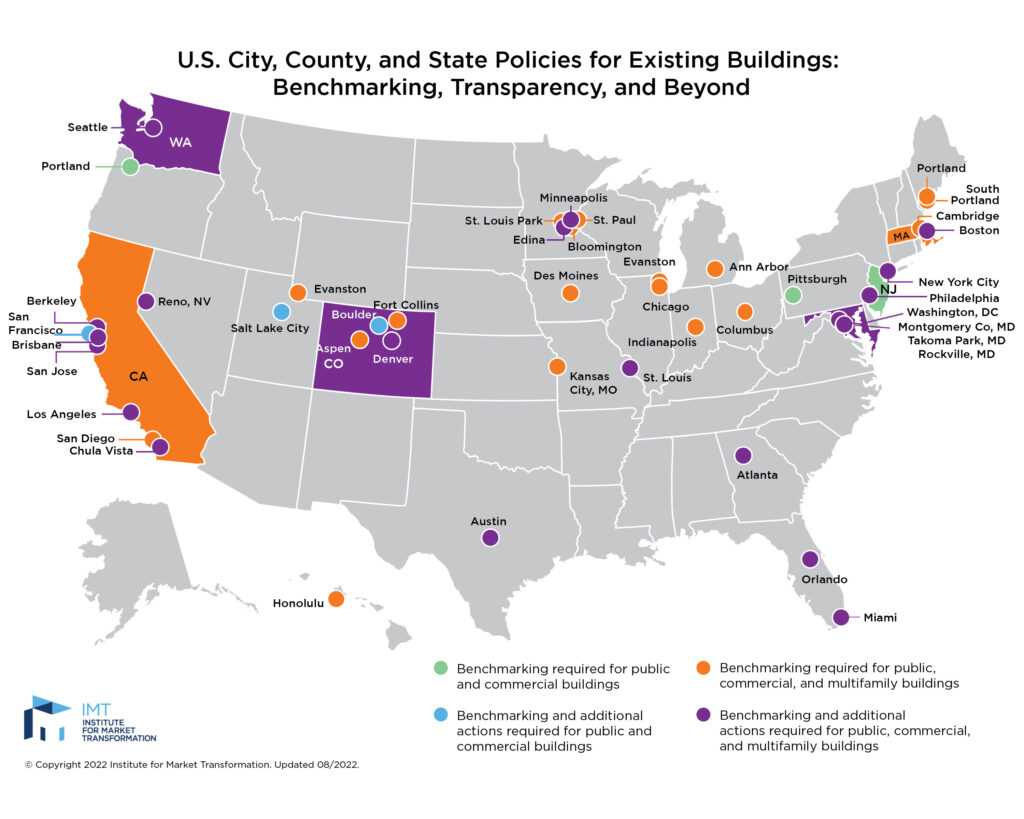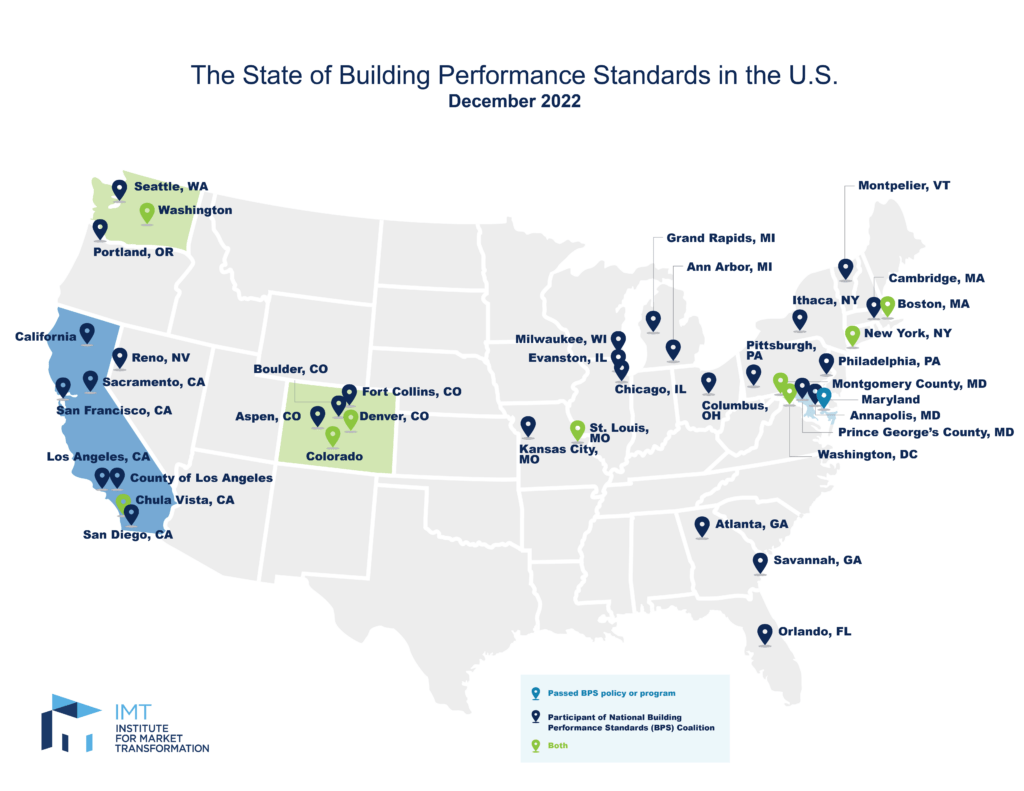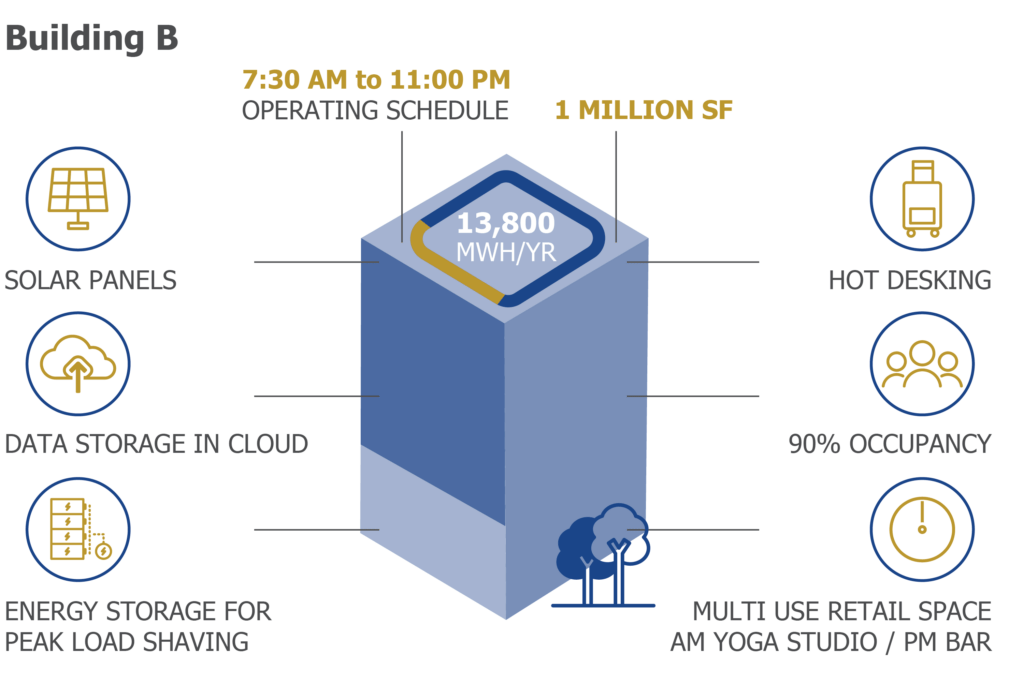In days past, a “high-performance” building meant an energy-efficient building with a low energy use per square foot. As certain jurisdictions shift their attention toward reducing greenhouse gas (GHG) emissions, electrifying heating systems, prioritizing equity, and generating clean and renewable electricity, this definition is evolving. Now jurisdictions are looking to incentivize building owners to adopt new features such as grid-and occupant-responsive controls, which is amplified by energy efficiency to help manage the cost of the clean energy transition and protect the reliability of the electric grid. All of these measures can translate into reduced energy burden, and healthier and more resilient buildings for communities.
Benchmarking requirements and building performance standards (BPS) are valuable levers of change
Historically, benchmarking requirements and more recently, Building Performance Standards (BPS), have been effective in encouraging the development of a strong market for high-performance buildings. Benchmarking drives market transformation by making building performance visible to consumers who want to live and work in efficient, low-carbon buildings. As part of the National Building Performance Standard Coalition, more than 35 state and local governments committed to passing building performance policies by 2024. These jurisdictions are sending a clear message: the nation’s stock of large buildings poised to become climate assets.


The intent of these policies is to accelerate GHG reduction from the built environment through energy-saving retrofits and electrification strategies. Currently, however, existing programs are using annualized aggregate energy and carbon emissions data to evaluate and compare building performance. While this yearly snapshot is useful for comparing the total energy consumption of two buildings of similar type, this method falls short when trying to evaluate a building’s energy responsiveness to real time occupancy, weather, electricity cost fluctuations, and energy-carbon intensity of the electrical grid. To measure performance across these metrics, more granular data on building electricity, occupancy, coincident weather, and grid emissions is needed.
Introducing Benchmark 8760
Benchmark 8760 is an initiative to evolve building performance standards and benchmarking methodologies — like those used by Energy Star Portfolio Manager (ESPM), New York City’s Local Law 97 (LL97) or Boston’s Building Emissions Reduction and Disclosure Ordinance (BERDO) 2.0 — to use hourly measured data rather than the monthly fixed and average inputs that are currently used.
Using hourly data in benchmarking and BPS could vastly improve policy makers’ ability to promote building performance features that support grid resiliency and carbon reductions. BPS policies that use carbon emissions as their metric of performance—such as those in Boston and New York City—primarily utilize annualized electricity grid coefficients as their baseline, though both have provisions in their proposed regulations allowing for future use of more granular grid emissions factors. The problem with annualized average carbon emission coefficients in general is that they don’t reflect the actual hour by hour variation in the electricity grid’s carbon intensity.
The Emissions Coefficients graphic below illustrates this dilemma. The blue line represents the flat annualized electricity coefficient used in NYC’s LL97, while the yellow line represents the hourly marginal emissions factor for the NYC load zone. If a building accounts for its operational carbon using the blue line values, the carbon impact appears to be the same every hour of the year. However, the yellow line shows that the variation in carbon content of electricity can fluctuate significantly over the course of the day. The gap between the blue lines and the others lines means we are misrepresenting the building’s overall carbon footprint and impact on the grid.

The seasonal, monthly, daily, and hourly variation in carbon intensity of the grid will become more pronounced as we move away from fossil fuel-based electricity generation and rely more heavily on renewable energy like solar and wind. To encourage renewable energy use, BPS should incentivize energy use at times of day when it is most available and energy storage at other times. BPS encouraging such demand response can only be done if the carbon intensity of the grid is reported hourly and compared to a building’s hourly electricity use.
Existing benchmarking platforms and BPS also often use approximate occupant density and typical hours of operation rather than real time building occupancy. Without a measurable and ongoing way to track occupancy, buildings are not incentivized to have occupancy-based controls and policies cannot set accurate BPS targets. With hourly occupancy data included in benchmarking tools and BPS, policymakers can more effectively recognize and reward buildings that adjust their energy use to best support the flow of people.
The real estate industry needs access to accurate data
Hourly building data can also provide benefits to building owners beyond strict policy compliance. As the electrification of buildings and phase out of natural gas equipment increases, building owners will face several challenges and opportunities. Challenges include rising energy bills and investment in infrastructure to support electrification. Opportunities include new potential revenue streams for load flattening and shifting, and increased resident satisfaction. A more granular analysis of building performance will help building owners change their operations to better meet climate goals and occupant needs.


The EPA’s benchmarking platform, Energy Star Portfolio Manager (ESPM), and NYC’s performance-based standard, Local Law 97, would both evaluate the two buildings below as equivalent performance. In reality, Building A is underutilized, while Building B is energy efficient, occupant-responsive, and grid-interactive.
For example, if a building has battery storage or on-site solar, hourly building electricity data alongside hourly grid GHG intensity data can be used to minimize carbon footprint while maximizing operational cost savings. Hourly weather data can be paired with hourly electricity data to determine how well a building’s heating or cooling systems respond to outdoor conditions. Similarly, hourly occupancy data can be used with hourly energy data to ensure the building’s ventilation systems are providing the right amount of fresh air to occupants rather than empty spaces. Insights from hourly data can help building owners optimize their controls, reduce overall carbon emissions and gather valuable information about building utilization. Pilots from the Federal government are already exploring such best practices.

The next generation of high-performance buildings will be energy-efficient, interactive with the grid, and responsive to people, so benchmarking and BPS practices have to adapt. The Benchmark 8760 Initiative has taken an important step forward by proving that collecting and storing hourly building electricity and occupancy data is not only possible, but can improve policies and city-wide programs to drive down emissions. Please visit the Benchmark 8760 website to download resources, read about project learnings, and view the initiative’s interactive hourly benchmarking prototype. Other helpful sites include the Department of Energy’s and National Association of State Energy Officials pages on Grid-interactive Efficient Buildings


